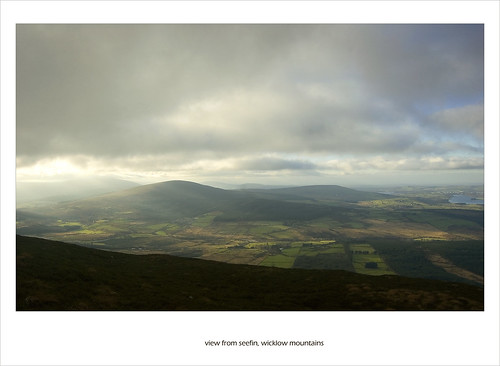 Kippure
Kippure
Classification: Dillon, Hewitt, Marilyn
Range: Wicklow Mountains
Mapsheet: 56
Walked previously
Kilbride Circuit
Date First Walked: Decemeber 12th 2009
Range: Wicklow Mountains
Mapsheet: 56
Distance: 11km
1. Seefin
Classification: Dillon
Height: 621 metres
County: Wicklow
My Dillon Count: 20
2. Seefingan
Classification: Dillon, Hewitt
Height: 724 metres
County: Dublin/Wicklow
My Dillon Count: 21
3. Corrig Mountain
Classification: Dillon, Hewitt
Height: 618 metres
County: Dublin/Wicklow
My Dillon Count: 22
4. Seahan
Classification: Dillon, Hewitt
Height: 648 metres
County: Dublin/Wicklow
My Dillon Count: 23
After what seemed like an eternity of weekends cancelled due to the Irish weather, the incessant rain finally stopped and the wind died down giving us a much-welcomed chance to get back out onto the hills. The varying plans for successive previous weekends, all of which had been cancelled, had included a walk up Croagh Patrick, a traverse of the Knockmealdowns and a walk in the Mournes. With the forecast predicting a dry weekend, we settled on a trip down to Wicklow having decided that negotiating the pre-christmas traffic around Newry would rule out the Mournes. I was joined on the trip by my neighbour Jason.
Compared to other ranges around the country, the rounded granite mountains of Wicklow can seem quite dull while the raised and blanket bog covering the range can make for very heavy going in places. In the past, I've struggled to get enthuaistic about a trip to Wicklow but this was overcome somewhat by the choice of an interesting circuit of the Kilbride Rifle Range to take in the 'Three Sees', namely the mountains of Seefin, Seegingan and Seahan, all of which were topped with passage tombs. The circuit also takes in the boggy hump of Corrig Mountain.
To add further flavour to the morning, we decided that we'd combine a recently resurrected hobby of running with our interest in hillwalking by staring off the morning with a run up the access road to the summit of Kippure. And so, at 9am on a cold Saturday morning, we found ourselves limbering up beside the gate at the foot of the access road looking up at the cloud-covered summit of Kippure for a glimpse of the RTE transmitter. Around 25 minutes later, I rounded the far corner of the fence enclosing the mast to reach the lonely trig pillar. Next step is to try out some hill-running proper! This was the second time I'd stood at the highest point of Dublin and like the last time, I was denied any view of the surrounding hills and could only catch glimpses of the 120 metre high mast as the clouds scurried by.
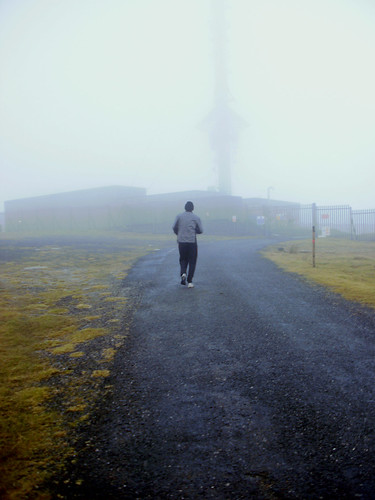
Jason nearing the top of Kippure

Feeling sumg after running up Kippure
After a leisurely jog back down the road and a bar of chocolate, a short drive took us to Kilbride Rifle Range outside which there is room for parking. From outside the range, a short walk along the road in a southerly direction takes you to it's edge where a fence runs uphill along a forest. You will pass a flag-pole which indicates whether or not firing is taking place in the range. It's then simply a case of following the edge of the forest uphill until it swings right at which point you need to take a bearing uphill. In keeping with my experience of the Wicklow Hills to date, navigation is easy due to a distinct track which leads all the way to the large cairn marking the summit of Seefin.

Jason atop Seefin
The impressive passage tomb is something of a miniature Newgrange and is the most interesting of the circuit. You will need to be both slim and agile to squeeze through the very narrow portal into the equally narrow and dark passage. However, you don't necessarily have to squeeze through the passage to get to the burial chamber itself as the roof of Seefin is open, presumably having collapsed at some stage in the distant past. A short and easy walk up Seefin would be the perfect walk for children who would enjoy exploring the cairn. Seefin marked something of a minor milestone for me being the 20th Dillon that I had climbed to date.
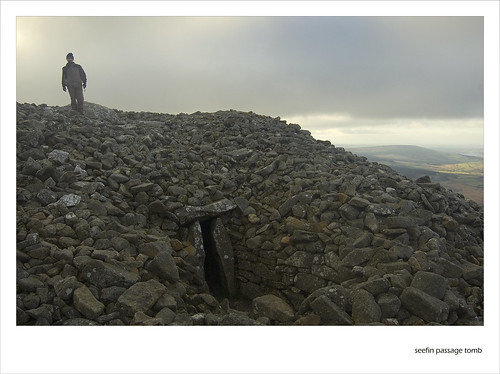
Me on the passage tomb atop Seefin
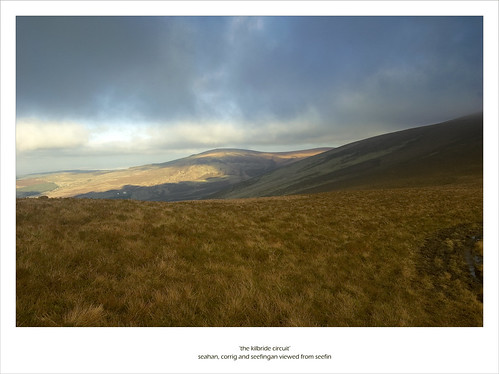
Seahan, Corrig and Seefingan viewed from below seefin
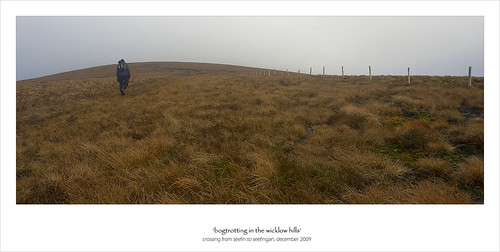
Jason crossing from Seefin to Seefingan
From Seefin, a short walk of about 1km along the edge of the firing range in a north-easterly direction takes you to Seefingan. A small section of boggy ground needs to be negotiated between the hills before reaching the broad summit of Seefingan. The cairn on Seefingan is similar in size to that of Seefin but unlike it's neighbour, it doesn't have a portal or chamber although an indentation on the east side of the cairn looks like it could have been a passage entrance. The cairn is topped by a concrete pillar which marks the edge of the firing range. The cairn is positioned away from the summit proper, presumably as it's position would make it more visible from the ground below. The summit proper is around 200 metres away from the cairn towards Kippure and for completionists, some very boggy ground has to be encountered to reach the top which is marked with a firing range sign.
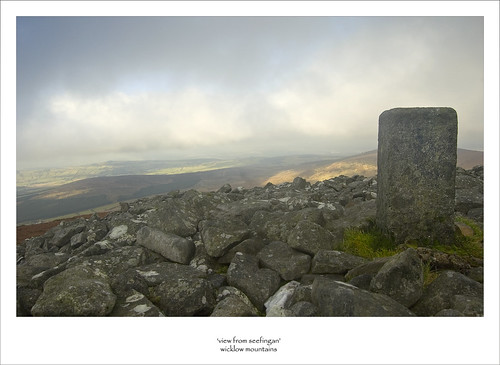
View from the cairn on Seefingan
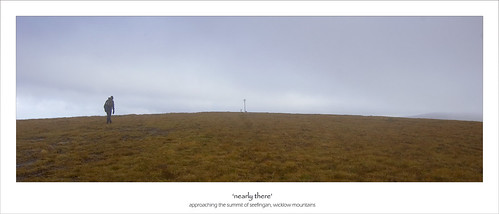
Approaching the summit proper of Seefingan
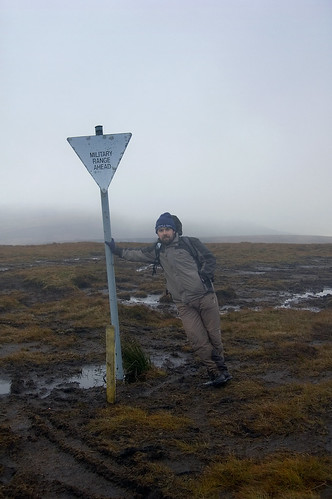
Me at the summit proper of Seefingan
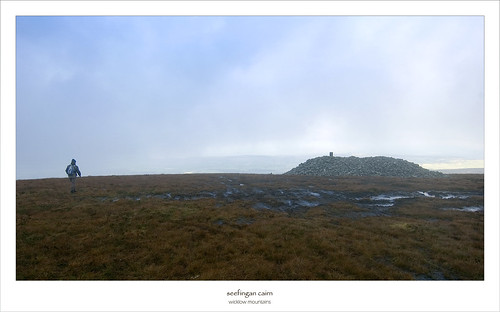
Walking across to the cairn on Seegingan
Next up is a longer slog across boggy ground towards Corrig Mountain, the poor relation of the circuit but a 'Dillon' nonetheless. The trudge was made worthwhile as the cloud-cover began to move away opening up stunning views across the Wicklow Mountains, the summit cone of the Great Sugar loaf poking out over the distant hills looking very much like one of the Great Pyramids of Egypt. The summit of Corrig is marked by another concrete pillar stood in the middle of a boggy pool. What the summit lacks in appearance, it makes up for with excellent views out to Dublin with Howth and Ireland's Eye visible to the North of the capital.

Heading for Corrig Mountain
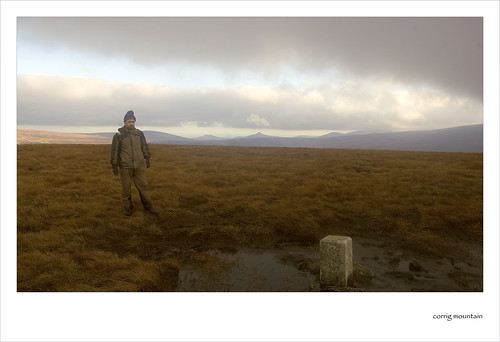
On the rather plain summit of Corrig Mountain
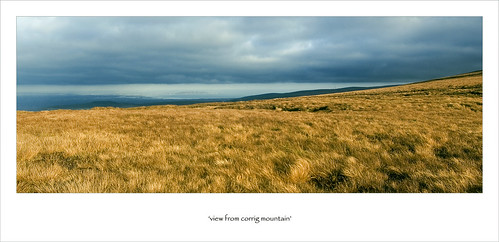
View from Corrig across Dublin and Howth
A very distinct and wide track leads from Corrig to Seahan, the last top of the circuit. For the first time of the day, the sun broke through the grey clouds and illuminated and coloured the slopes of Seahan. A short and easy walk of about 1km takes you to the top which contains a passage tomb, a cairn and a wedge tomb. The summit is marked by a large trig pillar sat atop the cairn. Again, the views are excellent and the summit of Seahan offers the best perspective of the circuit which you have just walked, the previous three tops clearly visible. From Seahan, head south-easterly to meet a track which will take you back to the road from which a walk of around 2km will take you back to the entrance of the firing range.
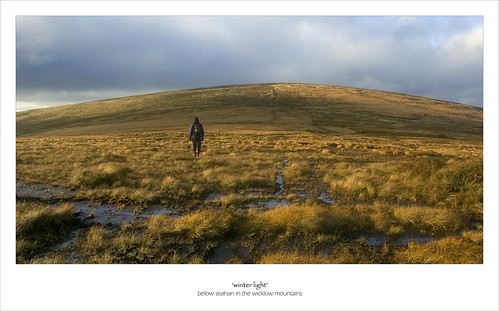
A rare bit of sun lights up the slopes of Seahan
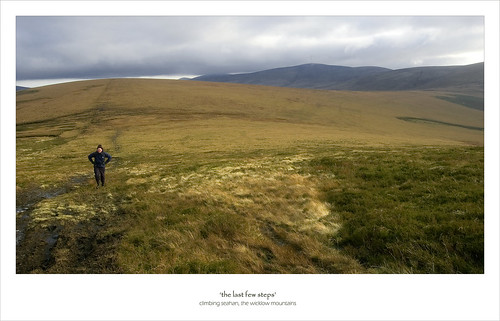
Jason climbing Seahan - Kippure mast visible in the background
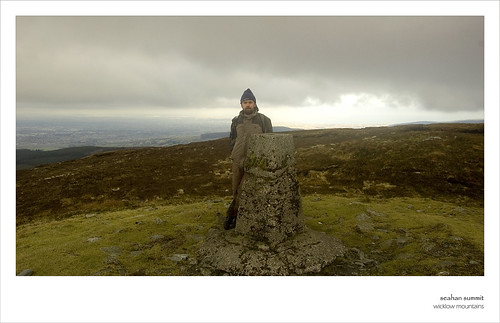
Me at the summit of Seahan
The circuit of the Kilbride Rifle Range offers the ideal walk for a winter's day. At 11km, the circuit can be comfortably completed in 4 hours while the cairns offer plenty of interest during the walk. It might be worth considering doing the route in reverse (Seahan first) thereby keeping the best tombs until last.
More Photos
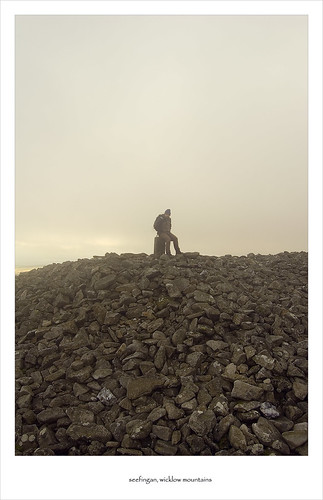
Time out on Seefingan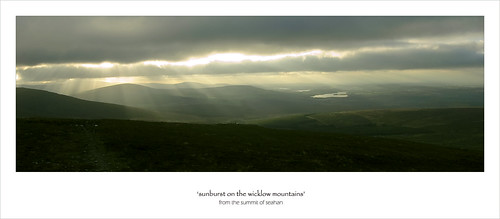
The sun breaks through the clouds over the Wicklow Mountains (from Seahan)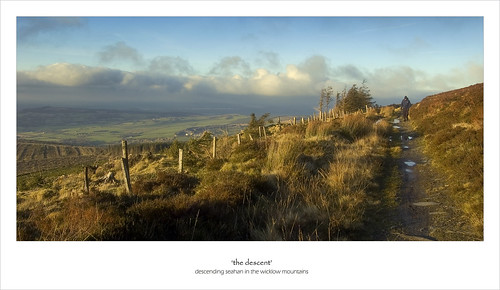
Descending Seahan - Find the track and you are grand!
Seefingan and Seefin
On the slopes of Seahan
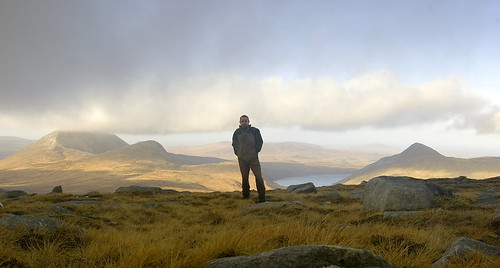 Date First Walked: November 13th 2009
Date First Walked: November 13th 2009
Range: Derryveagh Mountains
Mapsheet: 6
Distance: na
Classification: Dillon, Hewitt, Mailyn
Height: 652 metres
County: Donegal
My Dillon Count: 19
Having completed a very enjoyable walk of Muckish, I found myself quickly slipping back into a lazy state of mind back in the car and was in two minds as to whether or not to bother with Dooish. I took a drive out towards the mountain and decided that given that I was in the area and had some spare time on my hands, I might as well give it a go.
Compared to Errigal and Muckish, it's hard to get excited about climbing Dooish. The mountain stands at 652 metres, just a mere 14 metres lower than Muckish. However, from the R251, it appears merely as a hump along the ridge running from Maumlack to Saggartnadooish. From certain angles, Dooish looks quite like a dorsal fin rising gently from the surrounding sea of brown hills. In any case, it was deemed good enough by Paddy Dillon to qualify for inclusion in 'The Mountains of Ireland' so I was going to have to climb it at some stage.
To reach the base of the mountain, take the R251 towards Dunlewy. A few miles after the turn off for Falcarragh, you will see a pull-in point on a straight stretch of road which provides space for parking.
The walk is immediately hard-going over heavy boggy and tussocky ground and I found that the best approach is to keep to whatever high humps and bumps that can be found. There are a few streams to be crossed along the way and after passing under a power line, I had to remove my back-pack to squeeze through the strands of a deer fence. I'm not sure if this fence was to keep the deer in or out but having seen deer earlier in the day at the foot of Muckish, I saw a large group high on the slopes of Dooish which lies on the opposite side of the fence.

View from the upper slopes of Dooish

View across to the bulk of Muckish from close to the summit of Dooish
The direct line to Dooish is blocked by a small cliff so I picked a path up the east side of the mountain aiming for a gap above the col between Saggartnadooish and Dooish itself. I can only describe Dooish as something of a slog, the ground is boggy underfoot and very steep in places. Dooish is one of those mountains which makes you question your motives for hillwalking as it pulls and drags at your calf muscles with every step upwards. Around halfway up, I threw on my iPod partially to lift my mood but mainly to stop me from constantly reminding myself that I could by now be back at the hotel enjoying a hot shower.
Once more, I had the mountain to myself and I didn't see a single other walker during my time away frmo the car. The only brief company I had was higher up the mountain was I was suprised to see a field-mouse scurrying through some heather.
Eventually, the obvious slope leading to the summit came into view and after a short climb in a south-westerly direction, the boggy ground gave way to glorious rock and I reached the welcoming beehive cairn as Morrissey belted out 'Everyday is like Sunday' in my ear. I couldn't help myself but sing along. Despite it's relative lack of height and the fact that it's a short walk, reaching the summit of Dooish felt very rewarding for some reason.
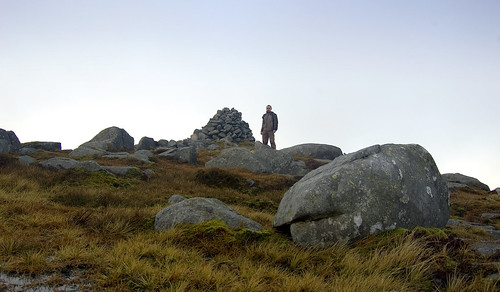
At the beehive cairn marking the summit of Dooish
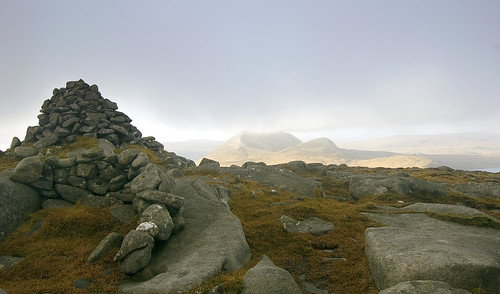
Summit cairn and shelter with Errigal and Mackoght in the background
The views from the summit are excellent running from Muckish to the north-east across to Aghla Beg then Aghla More and Errigal divided by Altan Lough and then on across the Glenveagh National Park. Not wanting to face back into the boggy ground I'd climbed up, I set off in a south-westerly direction swinging north at the col to take me back towards the road. Just off the summit is a small weather station of some kind with a data-logger attached, it's small turbine spinning frantically in the prevailing wind. There is some steep and slab-ridden ground to be encountered on the way down but with a bit of care, a route can be picked back down offering great views of Errigal all the way.
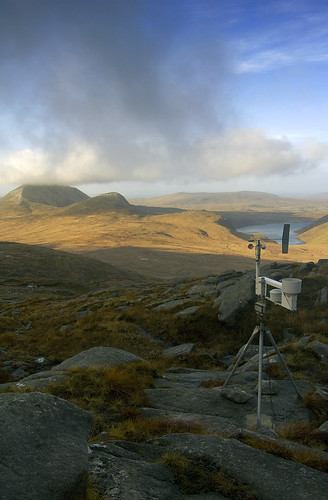
Small weather station just below the summit
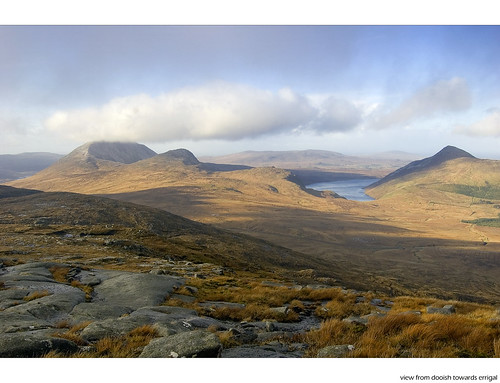
Descending Dooish opens up views towards Errigal, Makoght, Altan Lough and Aghla More
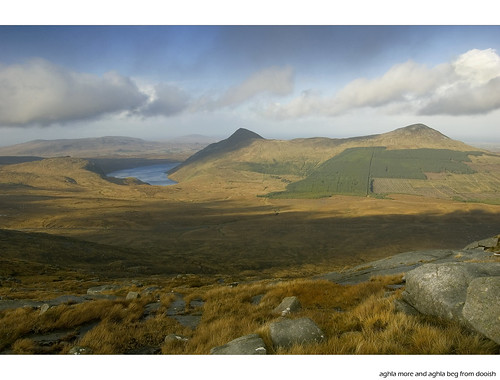
View across to the Aghlas (More and Beg) on the descent
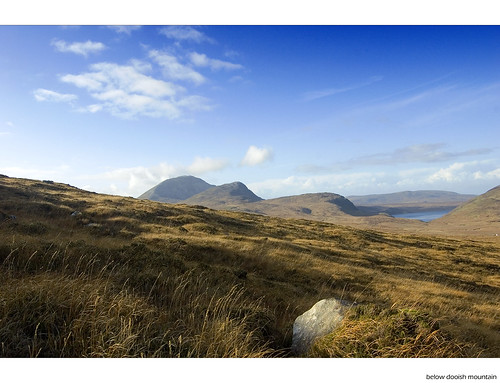
View from the lower slopes of Dooish
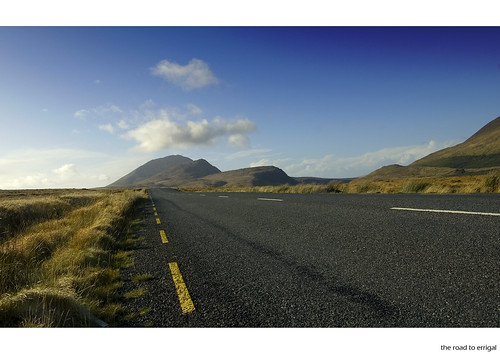
It's a short walk along the road (with great views to Errigal) back to the parking spot
All in all, a tougher climb than it looks mainly due to the steep and boggy ground which probably wasn't helped by heavy rain during the previous week. Despite this, it's a rewarding walk and a good way to get an alternative view of the surrounding hills. Just remember to bring the iPod!
 Date First Walked: November 13th 2009
Date First Walked: November 13th 2009
Range: Derryveagh Mountains
Mapsheet: 2Starting and Finishing Point: See map below
Distance: na
Classification: Dillon, Hewitt, Mailyn
Height: 666 metres
County: Donegal
My Dillon Count: 18
While driving towards Dunlewy to climb Errigal a couple of months previous, I was met with the spectactular sight, as I rounded a corner, of Muckish sitting illumniated under a vivid rainbow as the surrounding landscape lay hidden under heavy rain. I hadn't been familiar with this mountain beforehandbut on returning from Donegal, it had become a mountain that I really wanted to climb so when I found myself back in the area unexpectedly for a weekend, I made time to head back to the North-West of the county.
In any other area, this distinctive mountain would be an iconic landmark but given that Errigal is just a few miles away, Muckish somewhat understandably tends to get overlooked for it's famous neighbour. The Irish name of the mountain is 'An Mhucais' which translates as 'pig's back', a name which derives from the distinctive flat-top of the mountain. The flat top is crowned with a huge cairn which is visible for miles around as well as a metal cross which sits on a stone pedestal to the Northern end of the summit plateau. The southern end of the summit plateau gives way to an intimidating looking rocky cliff face.
There are two recognised routes up the mountain, one is via Muckish gap to the South with the second tougher option being via the 'Miner's path'. This follows a precipitous winding path up the northern side of the mountain, part of which was used by workers to reach an old and now defunct quarry where high grade quartz sand was mined on the it's flanks. Given that I was on my own and also the fact that I am a bit of a coward, I opted to take the easier option.
I approached the mountain from Letterkenny taking the turn onto the R255 towards Dunlewy a few miles after Kilmacrenan. This road meets the R251 from which spectactular views open up to the impressive south-east face of Muckish. The cairn atop the mountain can clearly be seen along this stretch of road and as you round several corners, you get the feeling that you are driving right into the mouth of this unusual mountain. Continue along the R251 until you see a sign for Falcarragh (An Fal Carrach). Take this turn which brings you up to Muckish Gap. There is a roadside shrine at the highest point of the gap and there is room to park either at the shrine or on the righthand side of the road just after the shrine.
Parking spot for Muckish View Larger Map
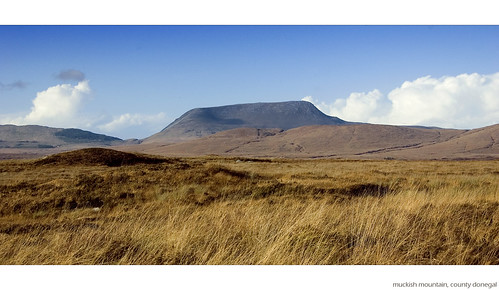
Approaching Muckish

At the foot of Muckish
From the parking spot, cross some boggy ground after which a short climb towards the obvious gap leads to a track. Follow this track which climbs very gently around the mountain and after a short walk, first the cross on the Northern edge of the summit will come into sight followed by the cairn to the southern end of the summit. At this point, you need to pick a path up the steep slope of the mountain and as you gain height, a rocky path just below the plateau leading towards the cairn will come into view.
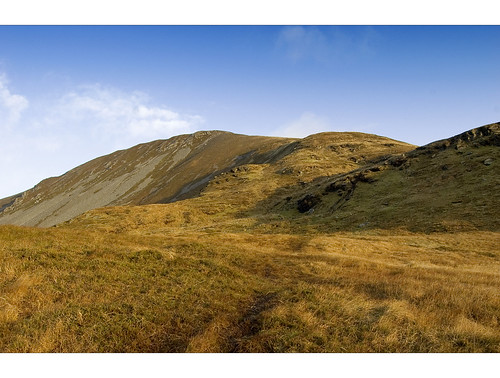
Aim for the obvious gap at the start of the climb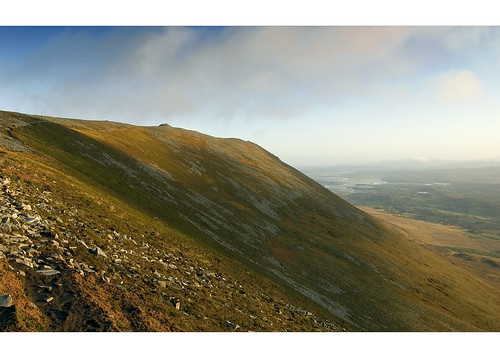
Climbing the south-eastern slopes of Muckish towards the large summit cairnThe last part of the climb along the rocky and peaty path leads onto the rock-strewn summit plateau of Muckish and it's fair to say that it really is otherworldy up there, somewhat akin to walking on the moon. After passing some smaller cairns, you will reach the massive cairn and from there, a very enjoyable walk takes you over to the trig pillar beyond which lies the large metal cross. The cross was placed on top of the mountain in 2000 replacing a wooden one which was destroyed in a storm. I'm not a fan at all of crosses on mountain summits but perhaps this one is understandable given the summit's spot height!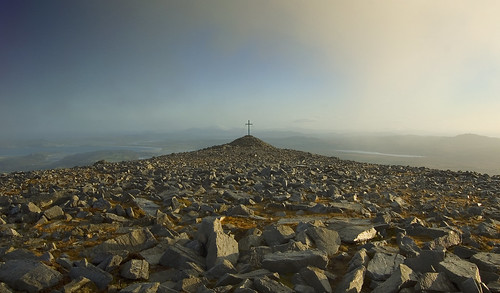
The cross on the Northern edge of the plateau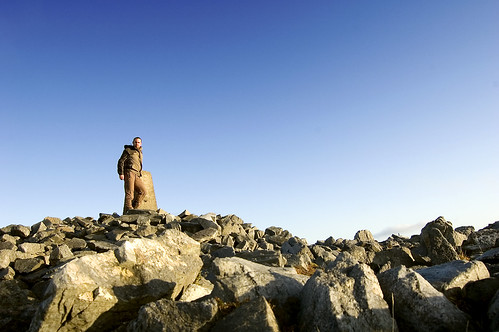
Me at the trig pillar - just a tad breezy!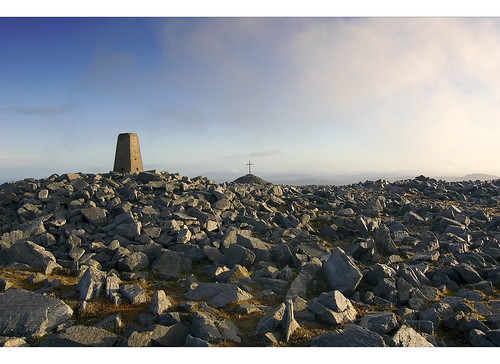
Muckish summit furnitureFrom the cairn, there are fantastic views along the route of the famous Glover Highland Walk taking in the Aghlas, Makoght and Errigal. The rocky hump just below the cross on the opposite end of the plateau offers contrasting panoramic views along the northern coast of Donegal taking in Rosguill in the foreground and stretching to Fanad as far as Inishowen dominated by Slieve Snaght and it's surrounding hills. As I stood at the trig point to take a couple of photos, a vivid rainbow briefly formed over Bloody Foreland to the North-West.
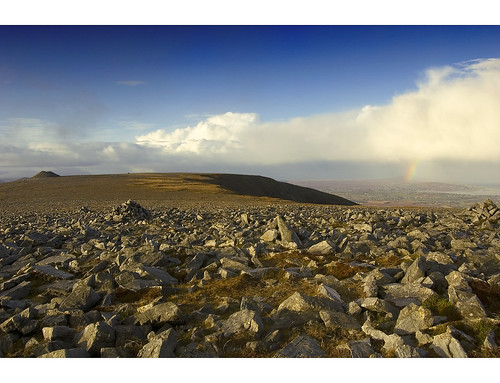
Rainbow over Bloody Foreland
After several rainy days, I had struck lucky and my walk along the summit was made in splendid November sunshine albeit with a biting gusty wind. The rocky plateau really is a wonderful place and is a real pleasure to walk although I have heard that it can be quite disorientating in mist.
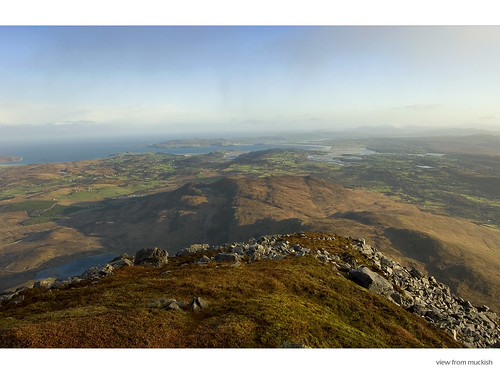
View from the northern edge of the plateau

View along the plateau back towards the summit cairn
I retraced my steps back down the mountain towards my parking spot. For the duration of my walk, I had not seen a single soul with my only brief company being a couple of deer who were making their way along the foot of the mountain.
Muckish quite simply is a wonderful and unusual mountain, easily walked from the Gap and highly recommended. While Errigal understandably hogs the limelight in the North-West of Donegal and is obviously and essential visit, make sure to combine a walk up it's glistening quartize slopes with a walk along the iconic and magnificent pigs back of Muckish.
More Photos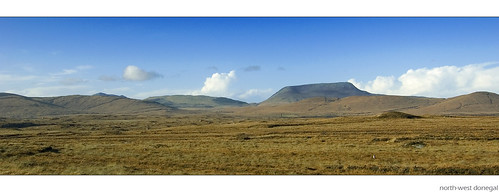
The wild north-west - Muckish and surrounding hills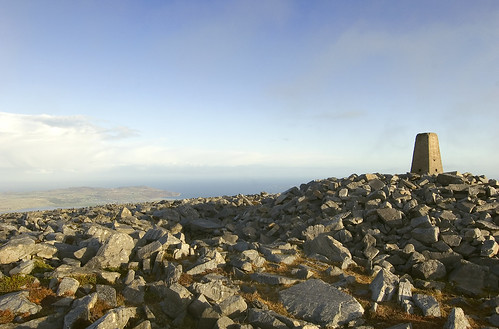
Trig Pillar marking the summit of Muckish - Horn Head in the background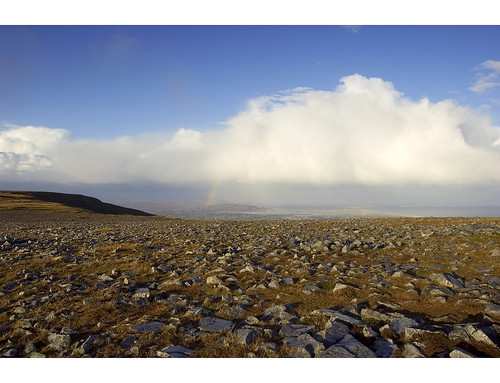
Rainbow over Bloody Foreland
Walking back towards the cairn
At the summit cairn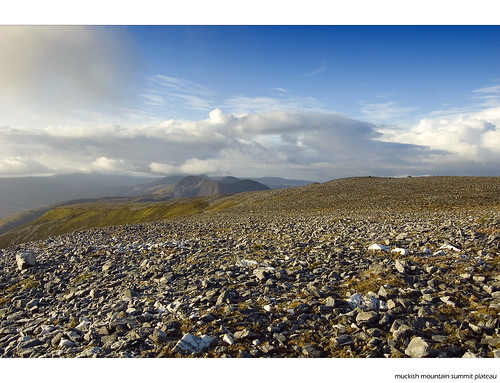
Looking along the summit plateau - descend via the path to the left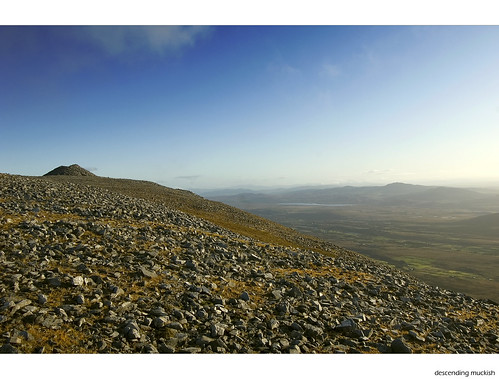
Descending Muckish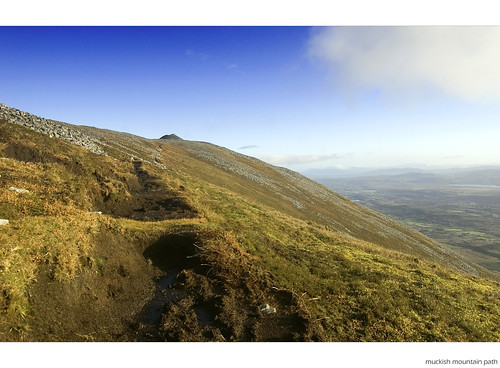
The eroded track back down Muckish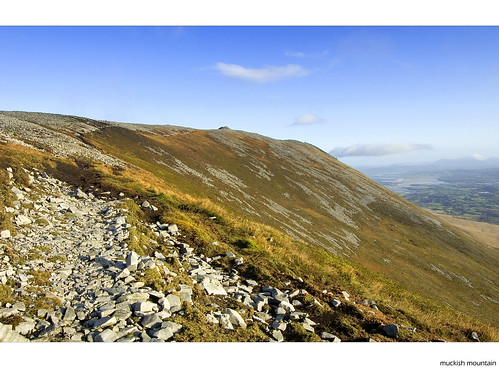
Rocky patch leading back down Muckish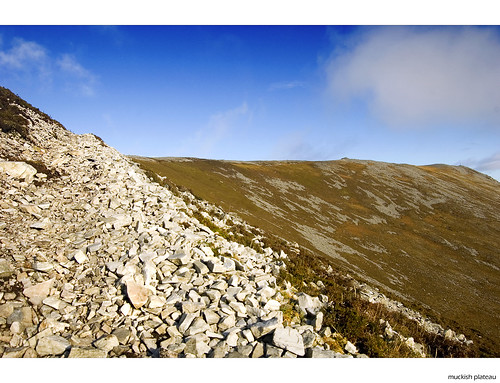
The long summit plateau of Muckish<
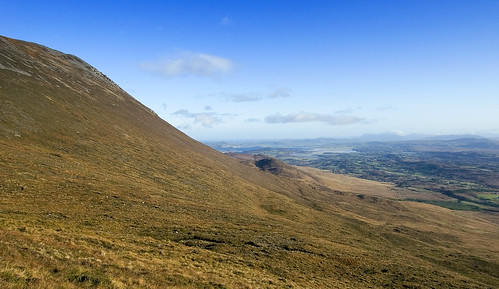
View from the lower slopes of Muckish






















































